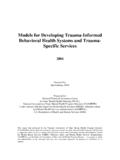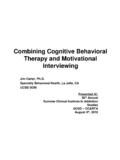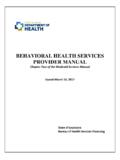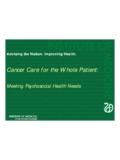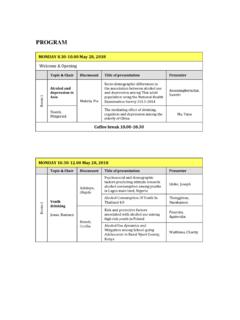Transcription of Practice Guidelines for Recovery-Oriented …
1 Practice Guidelines for Recovery-Oriented behavioral health Care connecticut Department of Mental health and Addiction Services No right is held more sacred, or is more carefully guarded, by the common law, than the right of every individual to the possession and control of his[/her] own person, free from all restraint or interference of others, unless by clear and unquestioned authority of law. United States Supreme Court (Union Pacific Railway Co. v. Botsford) Prepared for the connecticut Department of Mental health and Addiction Services by the Yale University Program for recovery and Community health (Tondora & Davidson, 2006).
2 2 Forward by Commissioner Thomas A. Kirk, Jr., The document that you are about to read is an extraordinary one in its origins, its content, and its value as another step toward achieving and maintaining a Recovery-Oriented health care service system in connecticut . In my view, if not the most important, the following document is one of the most significant products to result within the last five years from the public/private partnership composed of persons in recovery , families, staff and leadership of DMHAS, prevention specialists, private nonprofit service providers, the academic community, and other advocates and stakeholders. This collective group has focused on assessing and improving the quality of services available for persons with mental illness and/or substance use disorders in the State of connecticut .
3 Consider a few of its origins. Listening to the suggestions and continuing guidance of those who need or use our services is one of the most basic and essential characteristics of a Recovery-Oriented service system. Thus, beginning in 1999 we asked Advocacy Unlimited, Inc. and the connecticut Community for Addiction recovery , Inc. to work together to develop a set of recovery Core Values that could serve as guideposts for DMHAS as it began the journey of restructuring its service system. The result was 27 principles divided into four categories: Direction, Participation, Programming and Funding/Operations. Go to , click on major Initiatives, then recovery Initiative for further information about the recovery Core Values.
4 Well before 1999, there had been champions of recovery in any number of state and private service sectors who understood the meaning of recovery and the importance of it in the lives and care of the people receiving services. They now had the opportunity to speak in a louder voice and educate the rest of us. We all stand on the shoulders of those who came before us. DMHAS later hosted a few statewide recovery Conferences, established a recovery Institute and Centers of Excellence, and conducted a series of consensus-building retreats for executive directors, medical and clinical leadership, and several other stakeholder groups within the mental health and addiction service communities and elicited their views about the concept of recovery , what it would mean for their activities, and what gaps needed to be addressed and barriers removed for us to achieve a Recovery-Oriented system.
5 All of the above, and other work, led to the signing in September 2002 of Commissioner s Policy Statement No. 83 on Promoting a Recovery-Oriented Service System. This landmark policy designated the concept of recovery as the overarching goal, guiding principle, and operational framework for the system of care supported by the DMHAS. It incorporated the recovery Core Values. It stated that: We shall firmly embed the language, spirit, and culture of recovery throughout the system of services, in our interactions with one another and with those persons and families who trust us with their care. In addition, this policy envisioned and mandated services characterized by: 3.
6 A high degree of accessibility, effectiveness in engaging and retaining persons in care ..effects shall be sustained rather than solely crisis- oriented or short-lived ..age and gender appropriate, culturally competent, and attend to trauma and other factors know to impact on one s recovery ..whenever possible, shall be provided within the person s home community, using the person s natural supports. But how do you actually do a Recovery-Oriented service system? This key question remained after all of the above work and many current activities too numerous to mention. Absent answers to this question, one may think all this recovery stuff is conceptual.
7 It has no real meaning or practical reality. The focus will not really change our system. The following document answers this question by identifying eight domains of a Recovery-Oriented service system ranging from degree of participation of persons in recovery in the recovery planning and system development process to Identifying and Addressing Barriers to recovery . It then lists a dozen or so concrete, practical and well-researched action steps or Guidelines in each domain. It answers questions like: You will know when you are placing primacy on the participation of people in recovery The document gives examples, identifies potential barriers, and uses the words of people in recovery to explain what each domain means and what they can expect in that domain.
8 It includes a glossary and distinguishes a Deficit-based Perspective from a Recovery-Oriented , Asset-based Perspective. As service providers review their Agency recovery Assessment Plans and as DMHAS fiscal, service, and quality staff go about their business, they now will have a roadmap to inform policy, develop outcomes and funding strategies, and a framework to monitor our fidelity with the Guidelines of a Recovery-Oriented health care system. Persons in recovery and other recipients of services will know what to expect, what they need to be educated about, and what they have a right to demand in their interactions with the system. It is said that successful initiatives have a thousand fathers and mothers and failed initiatives are orphans.
9 I believe our journey to a Recovery-Oriented and transformed service system has many parents. I hope this document will help those who either cannot understand or who have not yet embraced a Recovery-Oriented service system to become another parent of this journey. I would welcome any comments about the above or your opinion of this document at May 5, 2006 4 Table of Contents Executive Summary Introduction Defining Our Terms recovery From recovery to Recovery-Oriented Care Practice Guidelines A. Primacy of Participation B. Promoting Access and Engagement C. Ensuring Continuity of Care D. Employing Strengths-Based Assessment E.
10 Offering Individualized recovery Planning F. Functioning as a recovery Guide G. Community Mapping, Development, and Inclusion H. Identifying and Addressing Barriers to recovery Recommended Resources for Further Reading Appendix Glossary of Recovery-Oriented Language Examples of Strengths-Based Conceptualizations 5 Executive Summary The notion of recovery has become the focus of a considerable amount of dialogue and debate between and among various constituencies within the mental health and addiction communities. Following a brief introduction to the topic, in which we clarify various sources of confusion about the term, these Practice guide-lines begin to operationalize the various components of DMHAS vision of a Recovery-Oriented system of behavioral health care.










